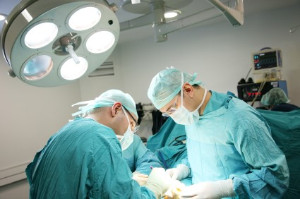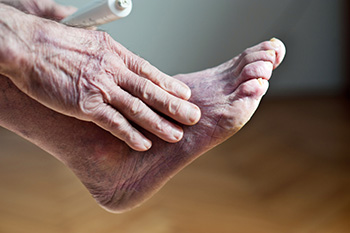Items filtered by date: June 2024
Plantar Fibroma Excision Surgery

A sign a plantar fibroma has developed is a noticeable lump in the arch of the foot. If it becomes painful or uncomfortable, surgery may be considered. In plantar fibroma excision surgery, managing postoperative healing is critical. Closed incision negative pressure therapy, or CINPT, and surgical drain placement are two techniques used for this purpose. CINPT involves applying a sealed dressing connected to a vacuum pump, which continuously removes fluid and reduces edema, promoting faster healing and minimizing infection risk. This method maintains a sterile environment and can improve wound outcomes. On the other hand, surgical drain placement involves inserting a tube into the surgical site to remove fluid buildup. While effective in preventing hematoma or seroma formation, it requires careful monitoring and regular emptying. Drains can sometimes increase the risk of infection and discomfort. Choosing between CINPT and surgical drains depends on the specific needs of the patient and the podiatric surgeon’s preference, with CINPT often providing a more advanced and less invasive option for optimal healing. If you have a plantar fibroma that is causing you pain and discomfort, it is suggested that you consult a podiatrist who can determine which type of surgery is right for you.
Foot surgery is sometimes necessary to treat a foot ailment. To learn more, contact the foot specialists of Certified Foot Care. Our doctors will assist you with all of your foot and ankle needs.
When Is Surgery Necessary?
Foot and ankle surgery is generally reserved for cases in which less invasive, conservative procedures have failed to alleviate the problem. Some of the cases in which surgery may be necessary include:
- Removing foot deformities like bunions and bone spurs
- Severe arthritis that has caused bone issues
- Cosmetic reconstruction
What Types of Surgery Are There?
The type of surgery you receive will depend on the nature of the problem you have. Some of the possible surgeries include:
- Bunionectomy for painful bunions
- Surgical fusion for realignment of bones
- Neuropathy decompression surgery to treat nerve damage
Benefits of Surgery
Although surgery is usually a last resort, it can provide more complete pain relief compared to non-surgical methods and may allow you to finally resume full activity.
Surgical techniques have also become increasingly sophisticated. Techniques like endoscopic surgery allow for smaller incisions and faster recovery times.
If you have any questions please feel free to contact our offices located in Larchmont and Brooklyn, NY . We offer the newest diagnostic and treatment technologies for all your foot and ankle needs.
Dealing With Morton’s Neuroma
 Morton's neuroma is a painful condition that affects the ball of your foot, usually between the third and fourth toes. This common issue is caused by the thickening of the tissue around one of the nerves leading to your toes. Thickening often occurs from excessive pressure or irritation from wearing tight or high-heeled shoes. Activities that involve repetitive foot stress, like running or certain sports, can also advance the development of Morton's neuroma. Morton's neuroma can significantly impact your ability to walk comfortably. As the tissue around the nerve thickens, it causes sharp, burning pain in the ball of your foot, which can make each step excruciating. The pain often spreads into your toes, causing numbness or a tingling feeling. Over time, walking or even standing for a long time can become hard, making it tough to complete daily activities and move around normally. The discomfort can also cause you to alter your walking pattern to avoid putting pressure on the painful area. This might lead to additional problems in areas such as the knee, hip, or back due to the uneven balance of weight. If you are struggling with Morton’s neuroma, it is highly suggested you consult with a podiatrist for an exam and diagnosis, followed by treatment options.
Morton's neuroma is a painful condition that affects the ball of your foot, usually between the third and fourth toes. This common issue is caused by the thickening of the tissue around one of the nerves leading to your toes. Thickening often occurs from excessive pressure or irritation from wearing tight or high-heeled shoes. Activities that involve repetitive foot stress, like running or certain sports, can also advance the development of Morton's neuroma. Morton's neuroma can significantly impact your ability to walk comfortably. As the tissue around the nerve thickens, it causes sharp, burning pain in the ball of your foot, which can make each step excruciating. The pain often spreads into your toes, causing numbness or a tingling feeling. Over time, walking or even standing for a long time can become hard, making it tough to complete daily activities and move around normally. The discomfort can also cause you to alter your walking pattern to avoid putting pressure on the painful area. This might lead to additional problems in areas such as the knee, hip, or back due to the uneven balance of weight. If you are struggling with Morton’s neuroma, it is highly suggested you consult with a podiatrist for an exam and diagnosis, followed by treatment options.
Morton’s neuroma is a very uncomfortable condition to live with. If you think you have Morton’s neuroma, contact the foot specialists of Certified Foot Care. Our doctors will attend to all of your foot care needs and answer any of your related questions.
Morton’s Neuroma
Morton's neuroma is a painful foot condition that commonly affects the areas between the second and third or third and fourth toe, although other areas of the foot are also susceptible. Morton’s neuroma is caused by an inflamed nerve in the foot that is being squeezed and aggravated by surrounding bones.
What Increases the Chances of Having Morton’s Neuroma?
- Ill-fitting high heels or shoes that add pressure to the toe or foot
- Jogging, running or any sport that involves constant impact to the foot
- Flat feet, bunions, and any other foot deformities
Morton’s neuroma is a very treatable condition. Orthotics and shoe inserts can often be used to alleviate the pain on the forefront of the feet. In more severe cases, corticosteroids can also be prescribed. In order to figure out the best treatment for your neuroma, it’s recommended to seek the care of a podiatrist who can diagnose your condition and provide different treatment options.
If you have any questions, please feel free to contact our offices located in Larchmont and Brooklyn, NY . We offer the newest diagnostic and treatment technologies for all your foot care needs.
Heel Pain Can Be Treated!
Fall Prevention Tips for Babies and Children

As babies and children explore their surroundings, falls are an inevitable part of their journey to independence. However, implementing precautionary measures can significantly reduce the risk of accidents and injuries. Start by creating a safe environment with secured gates at staircases and window guards to prevent falls from elevated surfaces. Ensure furniture is anchored to the wall to prevent tipping and keep floors clutter-free to minimize tripping hazards. When it comes to infants, always supervise them during diaper changes and avoid leaving them unattended on elevated surfaces such as changing tables or sofas. For toddlers and older children, teach them the importance of using handrails when climbing stairs and encourage safe play practices, such as not running indoors or jumping from high places. Additionally, provide age-appropriate toys and equipment and supervise them during activities such as climbing, swinging, or riding bikes. Many children’s feet can be affected from falling, which can hinder enjoying daily activities. If your child has fallen and has foot pain, it is suggested that you consult a podiatrist who can offer treatment solutions, and guide you on more effective fall prevention techniques for your children.
Preventing falls among the elderly is very important. If you are older and have fallen or fear that you are prone to falling, consult with the foot specialists from Certified Foot Care. Our doctors will assess your condition and provide you with quality advice and care.
Every 11 seconds, an elderly American is being treated in an emergency room for a fall related injury. Falls are the leading cause of head and hip injuries for those 65 and older. Due to decreases in strength, balance, senses, and lack of awareness, elderly persons are very susceptible to falling. Thankfully, there are a number of things older persons can do to prevent falls.
How to Prevent Falls
Some effective methods that older persons can do to prevent falls include:
- Enrolling in strength and balance exercise program to increase balance and strength
- Periodically having your sight and hearing checked
- Discuss any medications you have with a doctor to see if it increases the risk of falling
- Clearing the house of falling hazards and installing devices like grab bars and railings
- Utilizing a walker or cane
- Wearing shoes that provide good support and cushioning
- Talking to family members about falling and increasing awareness
Falling can be a traumatic and embarrassing experience for elderly persons; this can make them less willing to leave the house, and less willing to talk to someone about their fears of falling. Doing such things, however, will increase the likelihood of tripping or losing one’s balance. Knowing the causes of falling and how to prevent them is the best way to mitigate the risk of serious injury.
If you have any questions, please feel free to contact our offices located in Larchmont and Brooklyn, NY . We offer the newest diagnostic and treatment technologies for all your foot care needs.
Cold Feet Could Signal Poor Circulation
 Cold feet are often more than just a discomfort. They may be a sign of poor circulation, which is a condition where the blood flow to the extremities is inadequate, and often affects the feet. This issue can be caused by various disorders, including peripheral artery disease, or PAD. This condition reduces blood supply due to narrowed arteries. Diabetes can also damage blood vessels over time and result in poor circulation. Cold feet could also indicate Raynaud's disease, a condition that causes small blood vessels to tighten up or spasm, limiting blood flow under certain conditions. To address cold feet and poor circulation effectively, it is important to get to the root cause of the problem. If you frequently have cold feet, it is suggested that you consult a podiatrist who can assess your symptoms, help pinpoint the underlying cause, and recommend appropriate treatment.
Cold feet are often more than just a discomfort. They may be a sign of poor circulation, which is a condition where the blood flow to the extremities is inadequate, and often affects the feet. This issue can be caused by various disorders, including peripheral artery disease, or PAD. This condition reduces blood supply due to narrowed arteries. Diabetes can also damage blood vessels over time and result in poor circulation. Cold feet could also indicate Raynaud's disease, a condition that causes small blood vessels to tighten up or spasm, limiting blood flow under certain conditions. To address cold feet and poor circulation effectively, it is important to get to the root cause of the problem. If you frequently have cold feet, it is suggested that you consult a podiatrist who can assess your symptoms, help pinpoint the underlying cause, and recommend appropriate treatment.
Poor circulation is a serious condition and needs immediate medical attention. If you have any concerns with poor circulation in your feet contact the foot specialists of Certified Foot Care. Our doctors will treat your foot and ankle needs.
Poor Circulation in the Feet
Poor blood circulation in the feet and legs is can be caused by peripheral artery disease (PAD), which is the result of a buildup of plaque in the arteries.
Plaque buildup or atherosclerosis results from excess calcium and cholesterol in the bloodstream. This can restrict the amount of blood which can flow through the arteries. Poor blood circulation in the feet and legs are sometimes caused by inflammation in the blood vessels, known as vasculitis.
Causes
Lack of oxygen and oxygen from poor blood circulation restricts muscle growth and development. It can also cause:
- Muscle pain, stiffness, or weakness
- Numbness or cramping in the legs
- Skin discoloration
- Slower nail & hair growth
- Erectile dysfunction
Those who have diabetes or smoke are at greatest risk for poor circulation, as are those who are over 50. If you have poor circulation in the feet and legs it may be caused by PAD and is important to make changes to your lifestyle in order to reduce risk of getting a heart attack or stroke. Exercise and maintaining a healthy lifestyle will dramatically improve conditions.
As always, see a podiatrist as he or she will assist in finding a regimen that suits you. A podiatrist can also prescribe you any needed medication.
If you have any questions please feel free to contact our offices located in Larchmont and Brooklyn, NY . We offer the newest diagnostic and treatment technologies for all your foot and ankle needs.

